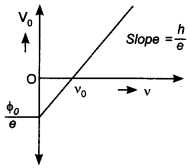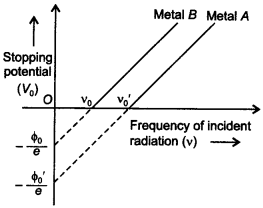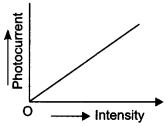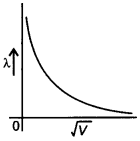Free PDF Download of CBSE Physics Multiple Choice Questions for Class 12 with Answers Chapter 11 Dual Nature of Radiation and Matter. Physics MCQs for Class 12 Chapter Wise with Answers PDF Download was Prepared Based on Latest Exam Pattern. Students can solve NCERT Class 12 Physics Dual Nature of Radiation and Matter MCQs Pdf with Answers to know their preparation level.
Dual Nature of Radiation and Matter Class 12 Physics MCQs Pdf
Dual Nature of Radiation and Matter MCQ Questions with Answers Pdf Question 1. Light of frequency 1.9 times the threshold frequency is incident on a photosensitive material. If the frequency is halved and intensity is doubled, the photocurrent becomes
(a) quadrupled
(b) doubled
(c) halved
(d) zero
Answer/Explanation
Answer: d
Explaination: (d) As vi = 0.95 v0. No photoelectric emission takes place.
Dual Nature of Matter And Radiation Class 12 MCQ Question 2. Threshold wavelength for a metal having work function W0 is X. What is the threshold wavelength for the metal having work function 2W0?
(a) 4λ
(b) 2λ
(c) λ/2
(d) λ/4
Answer/Explanation
Answer: c
Explaination:

MCQ on Dual Nature of Matter And Radiation Question 3. Radiations of frequency v are incident on a photosensitive metal. The maximum K.E. of the photoelectrons is E. When the frequency of the incident radiation is doubled, what is the maximum kinetic energy of the photoelectrons?
(a) 2E
(b) 4E
(c) E + hv
(d) E – hv
Answer/Explanation
Answer: c
Explaination: (c) Using Einstein’s photoelectric equation hv – w0 = E
4. Maximum kinetic energy (Ek) of a photoelectron varies with frequency (v) of the incident radiation as


Answer/Explanation
Answer: d
Explaination: (d) Using Einstein’s photoelectric equation hv = hv0 + Ek
Physics MCQs for Class 11 With Answers Pdf Question 5. The stopping potential V0 for photoelectric emission from a metal surface is plotted along y-axis and frequency v of incident light along x-axis. A straight line is obtained as shown. Planck’s constant is given by

(a) slope of the line
(b) product of the slope of the line and charge on electron
(c) intercept along y-axis divided by charge on the electron
(d) product of the intercept along x-axis and mass of the electron
Answer/Explanation
Answer: b
Explaination: (b) Using Einstein’s photoelectric equation
6. The energy of photon of wavelength 450 nm is
(a) 2.5 × 10-17 J
(b) 1.25 × 10-17 J
(c) 4.4 × 10-19 J
(d) 2.5 × 10-19 J
Answer/Explanation
Answer: c
Explaination:

7. The kinetic energy of an electron is 5 eV. Calculate the de broglie wavelength associated with it. (h = 6.6 × 10-34 Js, me = 9.1 × 10-31 kg)
(a) 5.47 Å
(b) 10.9 Å
(c) 2.7 Å
(d) None of these
Answer/Explanation
Answer: c
Explaination:
![]()
Photoelectric Effect Multiple Choice Questions and Answers Pdf8. The slope of the stopping potential versus ‘ frequency graph for photoelectric effect is equal to

(a) h
(b) he
(c) h/e
(d) e
Answer/Explanation
Answer: c
Explaination:
(c) Using Einstein’s equation for photoelectric effect
![]()
Class 12 Physics MCQ Chapter Wise Question 9. A proton and an α-particle are accelerated by the same potential difference. The ratio of their de broglie wavelengths (λp, λα) is
(a) 1
(b) 2
(c) √8
(d) \(\frac{1}{\sqrt{8}}\)
Answer/Explanation
Answer: c
Explaination:

Class 12 Physics MCQ Chapter Wise Question 10. Work function of three metals A, B and C are 4.5 eV, 4.3 eV and 3.5 eV respectively. If a light of wavelength 4000 Å is incident on the metals then
(a) photoelectrons are emitted from A.
(b) photoelectrons are emitted from B.
(c) photoelectrons are emitted from C.
(d) photoelectrons are emitted from all the metals.
Answer/Explanation
Answer: d
Explaination:
(d) Since energy of incident photon

11. Which of the following figure represents the variation of particle momentum and associated de Broglie wavelength?

Answer/Explanation
Answer: d
Explaination:
![]()
12. According to Einstein’s photoelectric equation the plot of the kinetic energy of the emitted photo-electrons from a metal vs the frequency of the incident radiation gives a straight line whose slope
(a) depends on the nature of the metal used.
(b) depends on the intensity of the radiation.
(c) depends both on the intensity of the radiation and the metal used.
(d) is the same for all metals and independent of the intensity of the radiation.
Answer/Explanation
Answer: d
Explaination: (d) Since slope = \(\frac{h}{e}\)
13. If K.E. of free electron is doubled, its de Broglie wavelength will change by factor
(a) \(\frac{1}{\sqrt{8}}\)
(b) √2
(c) \(\frac{1}{2}\)
(d) 2
Answer/Explanation
Answer: a
Explaination:
![]()
14. For a given kinetic energy which of the following has smallest de Broglie wavelength?
(a) Electron
(b) Proton
(c) Deutron
(d) a-particle
Answer/Explanation
Answer: d
Explaination:
(d) Since de Broglie wavelength

particle, mass of ∝-particle is maximum.
15. A particle is dropped from a height H. The de Broglie wavelength of the particle as a function of height is proportional to [NCERT Exemplar]

Answer/Explanation
Answer: d
Explaination:
![]()
16. A proton, a neutron, an electron and an a-particle have same energy. Then their de Broglie wavelengths compare as [NCERT Exemplar]
(a)λp = λn > λe > λα
(b) λα < λp = λn < λe
(‘C) λe < λp = λn > λα
(d) λe = λp = λn = λα
Answer/Explanation
Answer: b
Explaination:

17. In photoelectric effect what determines the maximum velocity of electron reacting the collector?
(a) Frequency of incident radiation alone
(b) Work function of metal
(c) Potential difference between the emitter and the collector
(d) All of these
Answer/Explanation
Answer: d
Explaination: (d) As per Einstein’s photoelectric equation
18. A Proton and an a-particle have the same de Broglie wavelength. What is same for both of them?
(a) Mass
(b) Energy
(c) Frequency
(d) Momentum
Answer/Explanation
Answer: d
Explaination: (d) Since λ = \(\frac{h}{p}\), for the same wavelength momentum is also same.
19. The wavelength of a photon needed to remove a proton from a nucleus which is bound to the nucleus with 1 MeV energy is nearly [NCERT Exemplar]
(a) 1.2 nm
(b) 1.2 × 10-3 nm
(c) 1.2 × 10-6 nm
(d) 1.2 × 101 nm
Answer/Explanation
Answer: b
Explaination:

20. An electron is moving with an initial velocity v = v0i and is in a magnetic field B = B0 j. Then, its de Broglie wavelength [NCERT Exemplar]
(a) remains constant.
(b) increases with time.
(c) decreases with time.
(d) increases and decreases periodically.
Answer/Explanation
Answer: a
Explaination:
(a) F = q(v × B) = F = qvB sin θ. As this force is perpendicular to v and B, so the magnitude of v will not change, i.e. momentum (p = mv) will remain constant in magnitude
De Broglie wavelength λ = \(\frac{h}{m v}\) remams constant
∴ Comparing wavelengths of proton and neutron, mp = mn, hence λp = λn.
21. Who established that electric charge is quantised?
(a) J.J. Thomson
(b) William Crookes
(c) R.A. Millikan
(d) Wilhelm Rontgen
Answer
Answer: c
22. Cathode rays were discovered by
(a) Maxwell Clerk James
(b) Heinrich Hertz
(c) William Crookes
(d) J.J. Thomson
Answer
Answer: c
23. The minimum energy required for the electron emission from the metal surface can be supplied to the free electrons by which of the following physical processes?
(a) Thermionic emission
(b) Field emission
(c) Photoelectric emission
(d) All of these
Answer
Answer: d
24. The phenomenon of photoelectric emission was discovered in 1887 by
(a) Albert Einstein
(b) Heinrich Hertz
(c) Wilhelm Hallwachs
(d) Philipp Lenard
Answer
Answer: b
25. A metal surface ejects electrons when hit by green light but nothing when hit by yellow light. The electrons will be ejected when the surface is hit by
(a) blue light
(b) heat rays
(c) infrared light
(d) red light
Answer
Answer: a
26. Which of the following statements is correct regarding the photoelectric experiment?
(a) The photocurrent increases with intensity of light.
(b) Stopping potential increases with increase in intensity of incident light.
(c) The photocurrent increases with increase in frequency.
(d) All of these
Answer
Answer: a
27. In photoelectric effect, the photocurrent
(a) depends both on intensity and frequency of the incident light.
(b) does not depend on the frequency of incident light but depends on the intensity of the inci-dent light.
(c) decreases with increase in frequency of inci-dent light.
(d) increases with increase in frequency of inci-dent light.
Answer
Answer: b
28. The maximum value of photoelectric current is called
(a) base current
(b) saturation current
(c) collector current
(d) emitter current
Answer
Answer: b
29. In photoelectric effect, the photoelectric current is independent of
(a) intensity of incident light
(b) potential difference applied between the two electrodes
(c) the nature of emitter material
(d) frequency of incident light
Answer
Answer: d
30. In photoelectric effect, stopping potential depends on
(a) frequency of incident light
(b) nature of the emitter material
(c) intensity of incident light
(d) both (a) and (b)
Answer
Answer: d
31. According to Einstein’s photoelectric equation, the graph of kinetic energy of the photoelectron emitted from the metal versus the frequency of the incident radiation gives a straight line graph, whose slope
(a) depends on the intensity of the incident radi-ation.
(b) depends on the nature of the metal and also on the intensity of incident radiation.
(c) is same for all metals and independent of the intensity of the incident radiation.
(d) depends on the nature of the metal.
Answer
Answer: c
32. The figure shows stopping V0A potential V0 and frequency o for two different metallic surfaces A and B. The work function of A, as compared to that of B is

(a) less
(b) more
(c) equal
(d) nothing can be said
Answer
Answer: a
33. Which phenomenon best supports the theory that matter has a wave nature?
(a) Electron momentum
(b) Electron diffraction
(c) Photon momentum
(d) Photon diffraction
Answer
Answer: b
34. The figure shows the variation of photocurrent with anode potential for a photosensitive surface for three different radiations. Let Ia, Ib and Ic be the intensities and va, vb. and vcbe the frequencies for the curves a, b and c respectively. Then the correct relation is

(a) va = vb and Ia ≠ Ib
(b) va = vc and Ia = Ic
(c) va = vb and Ia = Ib
(d) vb = vc and Ib = Ic
Answer
Answer: a
35. The photoelectric effect can be explained by
(a) Corpuscular theory of light
(b) Wave nature of light
(c) Bohr’s theory
(d) Quantum theory of light
Answer
Answer: d
36. Work function of metal is
(a) the minimum energy required to free an electron from surface against coulomb forces.
(b) the minimum energy required to free an », nucleon.
(c) the minimum energy to ionise an atom.
(d) the minimum energy required to eject an electron orbit.
Answer
Answer: a
37. The rest mass of a photon of wavelength X is
![]()
Answer
Answer: a
38. Photoelectric effect is based on the law of conservation of
(a) energy
(b) mass
(c) linear momentum
(d) angular momentum
Answer
Answer: a
39. Einstein’s photoelectric equation is:


Answer
Answer: a
40. In photoelectric effect, the number of photoelectrons emitted is proportional to
(a) intensity of incident beam. –
(b) frequency of incident beam.
(c) velocity of incident beam.
(d) work function of photo cathode.
Answer
Answer: a
41. Which of the following shows particle nature of light?
(a) Photoelectric effect
(b) Refraction
(c) Interference
(d) Polarisation
Answer
Answer: a
42. Relativistic corrections become necessary when the expression for the kinetic energy 1/2 mv², becomes comparable with mc², where m is the mass of the particle. At what de Broglie wavelength, will relativistic corrections become important for an electron?
(a) λ = 10 nm
(b) λ = 10-1 nm
(c) λ = 10-4nm
(d) λ = 10-3 nm
Answer
Answer: c
43. Two particles A1 and A2 of masses m1, m2(m1 > m2) have the same de Broglie wavelength. Then,
(a) their momenta are the same.
(b) their energies are the same.
(c) energy of A1 is greater than the energy of A2
(d) energy of A1 is equal to the energy of A2
Answer
Answer: a
44. Photons absorbed in a matter are converted to heat. A source emitting h photon/sec of frequency v is used to convert 1 kg or ice at 0°C to water at 0°C. Then, the time T taken for the conversion
(a) increases with increasing n, with v fixed
(b) decreases with n fixed, v increasing.
(c) does not remain constant with n and v changing such that nv = constant
(d) increases when the product nv increases.
Answer
Answer: b
45. A particle moves in a closed orbit around the origin, due to a force which is directed towards the origin. The de Broglie wavelength of the particle varies cyclically between two values λ1, λ2 with λ1 > λ2. Which following statements are true?
(a) The particle could not be moving in a circular orbit with origin as centre.
(b) The particle could not be moving in an elliptic orbit with origin as its focus.
(c) When the de Broglie wavelength is λ1 the particle is nearer the origin than when its value is λ2.
(d) When the de Broglie wavelength λ2, the particle is nearer the origin than when its value λ1.
Answer
Answer: d
46. Consider the following statements:
I. According to de Broglie hypothesis, particles have wave-like characteristics.
II. When an electron and a proton have the same de Broglie wavelength, they will have equal momentum.
Which of the above statements is/are correct?
(a) I only
(b) II only
(c) both I and II
(d) neither I nor II
Answer
Answer: c
47. Maximum photoelectric current at particular intensity of incident radiation, which becomes independent of anode potential is known as __________ .
Answer/Explanation
Answer:
Explaination: saturation current
48. Stopping potential is of intensity of incident radiation but proportional to __________ of the radiation.
Answer/Explanation
Answer:
Explaination: independent, frequency
49. Kinetic energy and stopping potential are zero, when frequency of incident radiation is equal to __________ .
Answer/Explanation
Answer:
Explaination: threshold frequency
50. According to Planck’s quantum theory of radiation, an electromagnetic wave travels in the form packets of energy called __________ .
Answer/Explanation
Answer:
Explaination: photon
51. __________ experiment has varified and confirmed the wave nature of electrons.
Answer/Explanation
Answer:
Explaination: Davisson and Germer
52. Photoelectric emission occurs only when the frequency of incident radiation is __________ than threshold frequency.
Answer/Explanation
Answer:
Explaination: greater
53. Photoelectric emission is an __________ process.
Answer/Explanation
Answer:
Explaination: instantaneous
54. De Broglie wavelength associated with an electron beam accelerated through a potential difference V is __________ proportional to √V.
Answer/Explanation
Answer:
Explaination: inversely
55. __________ is the minimum amount of energy required to cause photoelectric emission.
Answer/Explanation
Answer:
Explaination: Wok function
56. Wave associated with the material particle is known as __________ .
Answer/Explanation
Answer:
Explaination: matter wave
57. Name the phenomenon which shows the quantum nature of electromagnetic radiation. [AI2017]
Answer/Explanation
Answer:
Explaination: Photoelectric effect.
58. Define the term ‘threshold frequency’ in relation to photoelectric effect. [Delhi 2019, Foreign 2011]
Answer/Explanation
Answer:
Explaination:
Threshold frequency: For every metal surface, there is a minimum frequency of incident radiation, below which the photoelectric emission does not take place no matter what the intensity of incident radiation is and for how long the radiations are allowed to fall on the metal. This frequency is called threshold frequency.
59. Show the variation of photocurrent with collector plate potential for different frequencies but same intensity of incident radiation. [AI 2017, Foreign 2011]
Answer/Explanation
Answer:
Explaination:
For same intensity but different frequencies v1 > v2 > v3 of incident radiation.

60. In photoelectric effect, why should the photoelectric current increases as the intensity of monochromatic radiation incident on a photosensitive surface is increased? Explain. [Foreign 2014]
Answer/Explanation
Answer:
Explaination:
An increase in intensity means increase in number of photons and thus, increase in photoelectric current.
61. Show the variation of photocurrent with collector plate potential for different intensities but same frequency of incident radiation. [Delhi 2019, AI 2017, Foreign 2011]
Answer/Explanation
Answer:
Explaination:

62. What is the rest mass of a photon?
Answer/Explanation
Answer:
Explaination: The rest mass of a photon is zero.
63. The given graph shows the variation of photoelectric current (I) versus applied voltage (V) for two different photosensitive materials and for two different intensities of the incident radiation. Identify the pairs of curves that correspond to different materials but same intensity of incident radiation. [Delhi 2013]

Answer/Explanation
Answer:
Explaination: The materials with same intensity of incident light are 1 and 3; 2 and 4.
64. The graph shows the variation of stopping potential with frequency of incident radiation for two photosensitive metals A and B. Which one of the two has higher value of work function? Justify your answer. [Chennai 2019, Dehradun 2019]

Answer/Explanation
Answer:
Explaination:
As threshold frequency of metal A is greater, its work function, Φ = hv0, will also be greater than that of B.
65. For a given photosensitive material and with a source of constant frequency of incident radiation, how does the photocurrent vary with the intensify of incident light? [Delhi 2014, AI 2011C]

Answer/Explanation
Answer:
Explaination:
The photoelectric current increases linearly with the intensity of light as shown in the figure.

66. Ultraviolet radiations of different frequencies v1 and v2 are incident on two photosensitive materials having work functions W1 and W2 (W1 > W2) respectively. The kinetic energy of the emitted electrons is same in both the cases. Which one of the two radiations will be of higher frequency?
Answer/Explanation
Answer:
Explaination:
v1 > v2. As W1 > W2 and K.E. is same. From the relation,
hv = hv0 + \(\frac{1}{2}\) mv²
and hv0 = W= work function
67. Two beams, one of red light and the other of blue light, of the same intensity are incident on a metallic surface to emit photoelectrons. Which one of the two beams emits electrons of greater kinetic energy? [HOTS]
Answer/Explanation
Answer:
Explaination:
The blue light emits the electrons of greater K.E., as vb > vr.
68. Can non-metals show photoelectric effect? [HOTS]
Answer/Explanation
Answer:
Explaination: Yes, when they are exposed to electromagnetic radiations of higher frequency.
69. A photosensitive surface emits photoelectrons when red light falls on it. Will the surface emit photoelectrons when blue light is incident on it? Give reason. [Foreign 2017]
Answer/Explanation
Answer:
Explaination:
Since condition for photoemission is \(\frac{h c}{\lambda} \geq \phi_{0}\) (work function) and λB < λR hence, surface will emit photoelectrons.
70. What happens to the wavelength of a photon after it collides with an electron?
Answer/Explanation
Answer:
Explaination: The wavelength of a photon increases.
71. State de Broglie hypothesis. [Delhi 2012]
Answer/Explanation
Answer:
Explaination:
“Particles of matter moving with a given velocity (momentum) can display wave-like properties”.
\(\lambda=\frac{h}{p}\)
72. Write the expression for the de Broglie wavelength associated with a charged particle having charge q and mass m, when it is accelerated by a potential V. [AI2013]
Answer/Explanation
Answer:
Explaination:
De Broglie wavelength associated with a charged particle when accelerated by a potential V is given by
\(\lambda=\frac{h}{p}=\frac{h}{\sqrt{2 m q V}}\)
where m = mass of charge particle and q = charge on the particle
73. A proton and an electron have same kinetic energy. Which one has smaller de Broglie wavelength and why? [AI 2012]
Answer/Explanation
Answer:
Explaination:

74. Show on a graph the variation of the de Broglie wavelength (λ) associated with an electron with the square root of accelerating potential (V). [Delhi 2019, Similar Panchkula 2019, Foreign 2012]

Answer/Explanation
Answer:
Explaination:

75. Write the relationship of de Broglie wavelength λ associated with a particle of mass m in terms of its kinetic energy E. [Delhi 2011C]
Answer/Explanation
Answer:
Explaination:
The required relation is given by \(\lambda=\frac{h}{\sqrt{2 m E}}\)
76. Name an experiment which shows wave nature of electrons. Which phenomenon was observed in this experiment using an electron beam?
Answer/Explanation
Answer:
Explaination:
Experiment: Davisson and Germer
Phenomenon: Diffraction
77. Two lines, A and B, in the plot given below show the variation of de Broglie wavelength, λ versus 1/√V, where V is the accelerating potential difference, for two particles carrying the same charge. Which one of two represents a particle of smaller mass?

Answer/Explanation
Answer:
Explaination:

78. The de Broglie wavelength of a particle of kinetic energy K is λ. What would be the wavelength of the particle, if its kinetic energy were K/4 [HOTS]
Answer/Explanation
Answer:
Explaination:

79. An electron and alpha particle have the same kinetic energy. How are the de Broglie wavelength associated with them related? [Similar Delhi 2019]
Answer/Explanation
Answer:
Explaination:
![]()
80. Two metals A and B have work functions 2 eV and 5 eV respectively. Which metal has lower threshold wavelength?
Answer/Explanation
Answer:
Explaination:
Metal with work function 5 eV has lower threshold wavelength, i.e. metal B.
81. Show graphically how the maximum kinetic energy of electrons emitted from a photosensitive surface varies with the frequency of incident radiations.
Answer/Explanation
Answer:
Explaination:

82. What is the charge on metal in the photoelectric experiment?
Answer/Explanation
Answer:
Explaination: It will possess positive charge as it has lost electrons.
83. What is the momentum of a photon of
(i) frequency v, and (ii) wavelength λ?
Answer/Explanation
Answer:
Explaination:
(i) Energy of photon
E = hv = mc²
∴ Momentum of a photon = mc = \(\frac{hv}{c}\)
(ii) The momentum of a photon of wavelength λ is p = \(\frac{h}{\lambda}\).
where h is the Planck’s constant.
We hope the given Physics MCQs for Class 12 with Answers Chapter 11 Dual Nature of Radiation and Matter will help you. If you have any query regarding CBSE Class 12 Physics Dual Nature of Radiation and Matter MCQs Pdf, drop a comment below and we will get back to you at the earliest.